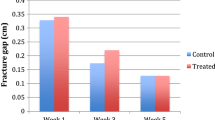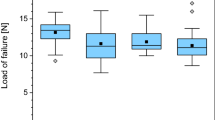Summary
This experimental study was undertaken in mice to investigate the procedures for storage of allogenic cancellous bone. Cancellous grafts were were stored at −80° C, −196° C or freeze dried. Grafts were implanted into a defect in the recipient's femur and after one week the cellular kinetic activity was analysed by autoradiography. For immunological study, the grafts were implanted into the recipient's muscle, and 2 weeks later the sensitising properties were examined by killer T-cell toxicity and the complement dependent cytotoxicity test. The capacity for osteogenesis of grafts frozen at −196° C was similar to or higher than those freeze dried, but it was low when storage was at −80° C. Immunogenicity was not affected by these three methods of storage and was very similar to that of fresh autografts. Antigenicity of allografts can be decreased by the freezing procedure. We suggest that the greater osteogenic potency after freezing at 196° C is related to the lesser degree of degeneration of the bone matrix.
Résumé
Cette étude expérimentale a été entreprise chez la souris pour apprécier les procédés de stockage de l'os spongieux allogène. Les greffes spongieuses ont été conservées à −80° C, à −196° C ou lyophilisées. Elles ont été implantées dans une cavité du fémur receveur et, au bout d'une semaine, l'activité cellulaire cinétique a été analysée par autoradiographie. Pour l'étude immunologique les greffes ont été implantées dans le muscle du receveur et sept semaines plus tard leurs propriétés sensibilisatrices ont été évaluées par la toxicité sur les lymphocytes T-killer et le test de cytotoxicité dépendant du complément. La capacité ostéogénique des greffes réfrigérées à −196° C était égale ou supérieure à celle des greffes lyophilisées, mais elle était faible quand elles étaient conservées à −80° C. L'immunogénicité n'était pas affectée par ces trois méthodes de conservation et était très analogue à celle des autogreffes fraîches. L'antigénicité des allogreffes peut être réduite par la lyophilisation. Nous pensons que le potentiel ostéogénique, supérieur après refroidissement à −196° C est lié au moindre degré de dégénérescence de la matrice osseuse.
Similar content being viewed by others
References
Brooks DB, Heiple KG, Herndon CH, Powell AE (1963) Immunological factors in homogenous bone transplantation. J Bone Joint Surg 45 [Am]: 1617–1626
Burwell RG (1963) Studies in the transplantation of bone, V. The capacity of fresh and treated homografts of bone to evoke transplantation immunity. J Bone Joint Surg 45 [Br]: 386–390
Elves MW (1974) Humoral immune response to allografts of bone. Int Arch Allergy 47: 708–715
Friedlaender GE (1983) Immune responses to osteochondral allografts. Clin Orthop 174: 58–68
Powell AE, Bos GD, Goldberg VM, Zika JM, Heiple KG (1983) Immune responses to bone allografts. In: Friedlaender GE (ed) Osteochondral allografts. Little, Brown, Boston pp 141–150
Urist MR (1965) Bone formation by autoinduction. Science 150: 893–899
Watanabe S (1986) Experimental studies on antigenicity and osteogenicity in allotransplantation of -196° C cortical bone. J Kyoto Pref Univ Med 95: 293–302
Author information
Authors and Affiliations
Rights and permissions
About this article
Cite this article
Mizutani, A., Fujita, T., Watanabe, S. et al. Experiments on antigenicity and osteogenicity in allotransplanted cancellous bone. International Orthopaedics 14, 243–248 (1990). https://doi.org/10.1007/BF00178753
Issue Date:
DOI: https://doi.org/10.1007/BF00178753




